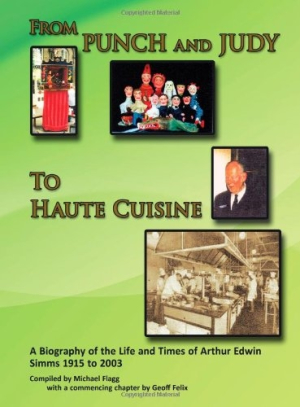From Punch and Judy to Haute Cuisine
A Biography on the Life and Times of Arthur Edwin Simms 1915-2003
English cuisine and the dreadful, dreary awfulness of it is a given among comedians and those who tour the British Isles on the cheap. But according to author Michael Flagg, this stereotype is no longer true, thanks in large part to Arthur Edwin Simms.
While few within, and even fewer outside, the cooking and catering world have ever heard of him, this “pioneer” in kitchen classroom education, as his biographer dubs him, revolutionized and professionalized food service at hotels, restaurants, and banquet halls the world over, starting with those in his native Great Britain.
Michael Flagg’s loving tribute to Simms, who passed away ten years ago, chronicles the life of a man whose introduction to British society began by helping his father stage Punch and Judy puppet shows for the royal family between the world wars. Sadly, Arthur’s childhood was not all fun and puppetry, for he suffered, as did many, from the ravages of the Great Depression. Fortunately for Simms—and for what would become his chosen profession—he enrolled in a cooking school in London in 1930, and the education he got there took him into the kitchens and dining rooms of some of the most renowned restaurants of the era.
Flagg provides a detailed account of Simms’s early years, along with many pictures and appendices, but perhaps his most interesting and thorough work appears in the fifth chapter, “The Road to Aldershot and Afterwards.” Quickly realizing that “the disparity in catering standards in the Army as opposed to the other two services had been acknowledged as far back as 1930,” Simms took it upon himself to push the Horse Guards to hire civilians to revamp military kitchens—even having them appoint a “chief inspector of Army catering” with the rank of colonel. It is a unique writer who can make a story about The British Army Catering Corps not only readable but interesting, although it does help that there is nostalgia these days for “the greatest generation” that served in World War II.
What follows are lengthy chapters on the schools and courses of education that Simms, as previously noted, pioneered to open up and professionalize what, until the 1950s, was a closed and haphazard system of hotel, restaurant, and catering management. While not the most exciting read, these chapters—which form the bulk of the book—are lavishly illustrated with photos, newspaper clippings, excerpts from conference and school documents, and other bits of memorabilia. Though this material is likely of minor interest to the general public, much of it might be considered a treasure to those who shared the times with Simms.
The book itself is physically unwieldy. It is heavy and floppy and very hard to hold and read—even flipping through it requires placing it upon a table. A different production format, perhaps more in the style of a traditional coffee-table book, would make it both more accessible and more attractive, as well as give it the “collectible” status it deserves.
From Punch and Judy to Haute Cuisine is unlikely to appeal to a general audience, but for those interested in the topic or who work or study in the industry, Flagg’s volume is of serious historical interest and value.
Reviewed by
Mark McLaughlin
Disclosure: This article is not an endorsement, but a review. The publisher of this book provided free copies of the book and paid a small fee to have their book reviewed by a professional reviewer. Foreword Reviews and Clarion Reviews make no guarantee that the publisher will receive a positive review. Foreword Magazine, Inc. is disclosing this in accordance with the Federal Trade Commission’s 16 CFR, Part 255.

